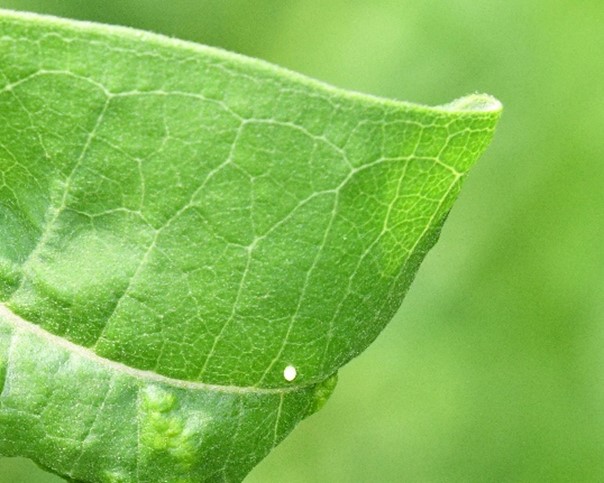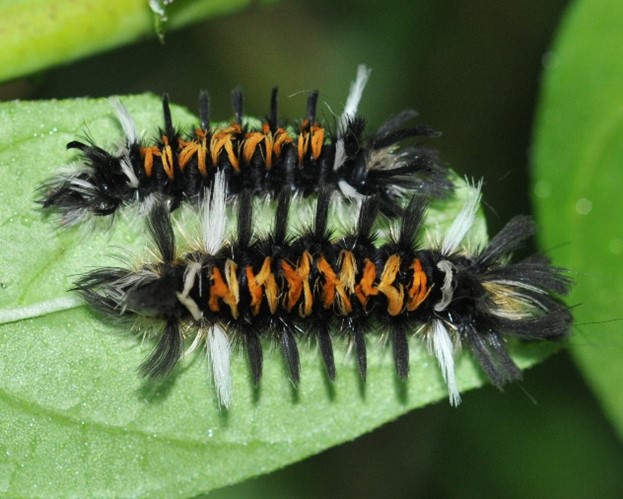A Celebration of the Common Milkweed (Asclepias syriaca) and Its Insect Community
By Roger Rittmaster
July 27, 2023
Alright, the Common Milkweed is common, but how much more would we appreciate this wonderful plant if it was called “Pink-flowered Milkweed” or “Velvet-leaved Milkweed”? Common implies ordinary, and there is little ordinary about this perennial plant. Adding insult to injury, the milkweed family (Asclepiadaceae) no longer exists and has been subsumed into the dogbane family (Apocynaceae), as if dogs cared.

A great place to see Common Milkweed is the field at Fernald’s Neck, a CMLT preserve in Lincolnville. Common Milkweed often spreads by underground roots called rhizomes and typically spaces itself as in this photo. This may have a survival advantage for the plant, as insect larvae that feed on it don’t have wings and are less likely to venture from one stem to another. Common Milkweed is easy to grow from seed in a sunny area, but beware, it loves to spread through its rhizomes and can be difficult to eliminate once established.
The leaves of Common Milkweed are large and covered with fine hairs, especially underneath, giving the leaves a velvety texture. Like most milkweeds, the veins (and stem) exude a sticky white latex if the leaves are eaten (hence the name milkweed). This latex can gum up the mouth parts of an unwitting insect. Milkweed latex also includes a group of toxic compounds called cardenolides or cardiac glycosides. These are similar to the medicine digitalis and can be lethal to susceptible insects. Yet, over 400 species of insects have evolved to tolerate the toxin, avoid being immobilized by the latex, and are able to eat milkweed.

There is some debate as to whether the Common Milkweed is edible or toxic to humans. Possibly both are true. There are many recipes for eating the shoots and young leaves of Common Milkweed after they are properly prepared by boiling. However, if eaten in large quantities or poorly prepared, I suspect they can cause gastrointestinal or other toxic effects.
The Monarch butterfly is special. Not only are its larvae (caterpillars) able to tolerate milkweeds toxins, they also concentrate them in their tissues, making them unpalatable to avian predators. Monarchs are totally dependent on milkweeds; that’s all their larvae will eat.

I watched this female Monarch ovipositing (placing eggs) on the underside of Common Milkweed. She curled her abdomen beneath her and deposited an egg on the underside of one of the upper leaves. Although a female lays as many as 300 eggs, it will only place one or two eggs on each plant. Many milkweed plants are needed to support Monarch populations, which is why anything humans do to decrease the amount of milkweed will adversely affect Monarchs.
Monarch egg (white dot) from the butterfly in the previous photo on the underside of a Common Milkweed leaf.


After 3-4 days, the egg will hatch. The tiny caterpillar eats its shell and then starts eating the milkweed leaf. As it grows, it periodically sheds its inflexible skin. The interval between molts is called an instar, and monarchs grow through 5 instars before pupating. The caterpillar in this photo was about 1 cm long and was probably starting the third instar. From hatching to pupation takes 10-14 days, depending on the weather and food supply.
Once the caterpillar is fully grown, it leaves the milkweed plant and searches for a place to pupate. The caterpillar in this photo is in the process of leaving its milkweed plant. Notice the subtle difference in color pattern between this fifth instar larva and the third instar above.

Once the caterpillar finds a suitable spot to pupate, it assumes a J-shaped posture and remains as such for 24-48 hours.


Then, in less than 30 minutes, the caterpillar sheds its skin for the last time, revealing the pre-formed chrysalis inside. Over another 10-14 days, the caterpillar metamorphoses into an adult butterfly inside the chrysalis. The process of emerging from the pupa is called eclosure (verb: to eclose). The entire process from egg to adult takes about 30 days.
There are several other insects in our area that are closely associated with milkweeds.
The Milkweed Leaf Beetle (Labidomera clivicollis) lays groups of eggs on the underside of milkweed leaves. The larvae and adults sever a vein upstream of where they feed to limit their exposure to the latex (a common practice with insects that feed on milkweed leaves). When they are finished eating, the larvae drop off the plant and pupate in the ground. They overwinter as adults in the ground. This leaf beetle can be seen throughout the summer and early fall.


The larvae and adults of the Large Milkweed Bug (Oncopeltus fasciatus) feed mainly on milkweed seeds. The adults migrate here from more southerly locations and are seen most frequently from August through October. As the days shorten and the weather cools, the new adults migrate back south.
The previous two insects are a good example of how to distinguish beetles (Order Coleoptera) from “true bugs” (Suborder Heteroptera). Beetles have two wing covers called elytra which meet in the middle, creating a line down the middle of the back. True bugs have wings that cross each other, often creating an X pattern, as seen in the Large Milkweed Bug. Also, note the similarity in coloration between the two insects. The bright orange and black pattern advertises the fact that these insects are foul-tasting and perhaps poisonous. Predators, such as birds, quickly learn to avoid them. Secondly, the fact that they both taste bad and mimic each other is called Mullerian mimicry. The more orange and black insects around, the less likely an individual insect will be attacked. Other orange and black insects that are not foul-tasting or poisonous may also mimic these insects, in which case it is called Batesian mimicry.

The last insect I would like to highlight is the Milkweed Tussock Moth (Euchaetes egle). The adults lay eggs on the underside of older, lower leaves of Common Milkweed. The caterpillars initially feed as a group, skeletonizing the leaves, and avoiding the latex in the veins. The hairs (setae) are urticating, meaning that they can cause an irritating rash. Once again, the orange and black coloration advertises its lack of palatability. The caterpillars are found on milkweeds in August and September.
Common Milkweed has a fascinating means of reproduction. The flowers contain both male and female parts. Like many flowers, it has typical sepals and petals. However, that’s where the similarity ends.
The center of the flower contains 5 hoods, which hold copious nectar to attract pollinators. Central to the hoods are 5 anthers (male) surrounding the pistil (female). The anthers are partially split, creating an opening called the stigmatic slit, leading to the stigmatic chamber. Instead of being loose grains, as is typical of most flowers, the pollen is packaged within sticky structures called pollinaria inside the stigmatic chambers.

For pollination to occur a pollinator (usually a bee) must inadvertently place a leg through the stigmatic slit and have a pollinaria attach to its leg. When the pollinator flies to a flower on another plant, it must slip the leg through another stigmatic slit into an empty stigmatic chamber. The pollinaria must remain in the chamber to fertilize an ovary in the center of the flower.

This photo shows a honey bee on Asclepias tuberosa (Butterfly Weed, another milkweed). Its left rear leg is inserted and temporarily caught in a stigmatic slit. While I was watching the bee this happened three times, and each time the bee was able to extract the leg with a bit of tugging. Sometimes an insect is stuck, unable to extract its leg, and at other times an insect may lose a leg.

This American Nursery Web Spider (Pisaurina mira) made its home on a Common Milkweed plant. It is missing 4 legs, which I suspect are stuck in stigmatic slits. As long as it’s able to feed, spiders are able to regenerate lost legs.
To some people, milkweeds are indeed weeds. If you are one of these people, I hope you’ve enjoyed this venture into the weeds.

